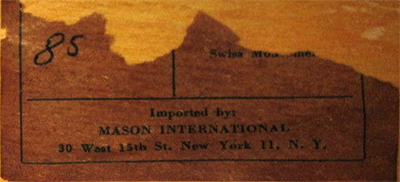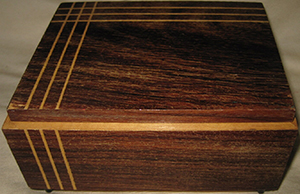|
Die Calames Paul Calame-Jaccard (Großvater) Louis Calame (Vater) André Calame (älterer Sohn) Jean Calame (jüngerer Sohn)
Paul Calame-Jaccard Fabrique du Nord Calame “Its origin went back to 1944. Marcel Calame was farming in the Pȃquier-aux-Vaux, to the North of Sainte-Croix, next to his cobbler´s shop. He had two sons. André, the elder of the two, trained at the School of Precision Mechanics in Sainte-Croix. He went to work for Paillard where he proved to be a talented and ingenious worker, taking after his grandfather, Paul Calame-Jaccard, master showmaker and patent holder. The younger son, Jean, born in 1923, went to secondary school and first worked as postman in the German part of Switzerland and then in Sainte-Croix, where he took on the job of workshop secretary at Paillard. He subsequently went to Zurich to study at a private commercial school.” (Piguet) Jean Calame. Ste-Croix, Switzerland. Founded post-war as maker of small musical movements. Discontinued c. 1960. “In 1944, André learned that there was a demand in Sainte-Croix for work in the mechanical and music box sector so he decided to set up his own company. To make him happy, the chicken run at the farm was demolished and replaced by a workshop. André purchased a set of old, dirt-clogged machine-tools, lathes and milling machines etc. from an old lathe worker. Work came pouring in at once and his company thrived under the name André Calame & Cie. SA. It was registered for the first time on 31st May 1945.” André Calame & Cie. SA (1945–1956) “During that particular year, more equipment was bought: a press and a large automatic lathe, which allowed him to expand his manufacturing operations. He did die stamping and lathe work, made rings for fishing rods, tea and ice cream spoons and various parts for music boxes.” “In 1946, steady development and increasing demand encouraged him to change structure of company, then employing about ten people. Lack of experience in corporate management and also unbridled growth led to its downfall. Jean, who had commercial qualifications, took steps to take over the company at the end of 1948, thus ensuring continuity of the operation under the name Fabrique du Nord, Jean Calame. This new company was recorded in the Trade Register five years later, on 16th February 1953. Ist objectice was music box manufacture, mechanical engineering, metal production and various apparatus, situated in the Rue de la Promenade.”. “There was then a considerable demand for musical movement components. As the necessary tooling already existed, Marcel Calame decided to expand, which implied looking for new premises to install a real mechanical workshop. He built a wooden hut, heated by a sawdust stove. Three experienced mechanics and die makers worked there for many years. The company produced cylinders, speed governors, ratchet wheels, stoppers, keys etc.” “While Jean was responsible for administrative and commercial matters, André managed all the mechanical and technical aspects. He built tooling and special machines for the manufacture of combs. At that particular time, the company was capable of making all the specific parts needed to produce an eigtheen-note musical movement, with the exception of the bedplate. So André decided to make bedplates of embossed iron (instead oft he usual injection-molded cast iron).” “In 1948, the music box industry was exploding. “The company prospered and was soon cramped for room. The Calame brothers chose a portable army hut,which they went to pick up in Gland. The assembly workshop was installed at the bottom oft he Rue de la Promenade. [...]” “His machinery and equipment was spread out all over, in several workshops, an apartment and wooden huts. This did not leave the local authorities unmoved, because complaints had been coming in since 1946. However, the initial project to build a factory was refused as it was in a “nonindustrial” zone. Then, in 1950, the battle spreaded to the trenches. Fire insurance, communal authorities and trade unions were alarmed. First came warnings and threats, and then an ultimatum to close down the company. The Calame brothers were not impressed.” “The Municipality of Sainte-Croix had to ask the cantonal authorities to apply the decisions of the authorities.” “But the Calame brothers had a better idea and discreetly made plans to build a proper factory.” “Marcel Calame owned a piece of land behind the Stand in Sainte-Croix, but because there were no blueprints, the construction project could not be published officially right away.” Fabrique du Nord SA (1956–1968) “In Spring 1956 a public company was set up under the name Fabrique du Nord SA, whose objectives were to purchase, sell and manufacture various mechanisms, appliances, instruments, musical movements and boxes als all financial and commercial operations related thereto.” “Between 1956 and the beginning of 1960, the Fabrique du Nord employed about forty-five people in workshops and more than fifty at home for cylinder-pinning, assembly, comb-tuning and damper fitting. They still made music boxes with pinned cylinders which gave more elasticity and a smoother sound than the injected cylinders.” “In the sixties competition from Japan became a problem. The Fabrique du Nord could not invest sufficiently to automate its music box production line, with the result that it had to be progressively abandoned. The company fell back on the production of tools and plastic injection molds, metalwork and subcontracting for the larger companies in the village. The staff was reduced to about a dozen in 1965, when André calame left. The factory was sold in 1968.” Several Sainte-Croix manufacturers brought back from Geneva one or more of these [coin operated] automata. [...] Louis Cagnaux, who [was] music box manufacturer] in Yverdon (Compare Piguet, Faiseurs, (1996), p. 282-286, see Piguet, Music Box Makers, 2004, p. 60 and 203-207)
[1] no s/n
[2] Merry Widow
|



.jpg)
.jpg)
.jpg)